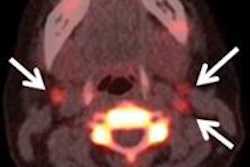Whole-body FDG-PET/CT offers "excellent diagnostic performance" in the assessment of distant malignancies in patients with head and neck, breast, and lung cancers, according to a new study in the Journal of Nuclear Medicine.
A meta-analysis of 41 studies by Chinese researchers found that whole-body FDG-PET/CT achieved overall sensitivity of 93% and specificity of 96% in these forms of cancer. In cases of breast cancer, the hybrid modality achieved sensitivity of 97% and specificity of 95%, according to a research team led by Dr. Guozeng Xu of the Evidence-Based Medical Center and the First Affiliated Hospital of Guangxi Medical University in Nanning (JNM, December 2012, Vol. 53:12, pp. 1847-1854).
Xu and colleagues noted that while conventional imaging modalities such as chest radiography, CT, abdominal ultrasound, and bone scans are commonly used to detect distant metastases and second primary cancers, these modalities "often do not reliably characterize the extent of disease, because it is difficult to identify small distant lesions on the basis of morphologic criteria and to distinguish potential metastatic lesions from benign findings."
Previous research has shown that that FDG-PET/CT is more sensitive and specific than conventional imaging modalities in detecting distant malignancies in cancer patients at initial staging before treatment or restaging after treatment.
Meta-analysis
The researchers looked for studies from January 2000 to April 2012 in Medline and Embase that evaluated the use of whole-body PET/CT to assess distant metastases with or without second primary cancers in patients with various forms of cancer.
There were 41 studies that complied with researchers' inclusion criteria and were analyzed for the diagnostic accuracy of whole-body PET/CT to detect distant malignancies. In 21 studies, only patients with primary cancer were enrolled; 14 studies included only patients with recurrent cancer and six studies evaluated a combination of patient populations.
The 41 studies included a total of 4,305 patients and had an overall sensitivity of 93% for FDG-PET/CT and a specificity of 96%. The review found that the type of eligible patients, prevalence of distant malignancies, imaging analysis, and study design did not statistically significantly influence the sensitivities and specificities of FDG-PET/CT.
Xu and colleagues also calculated positive likelihood ratios (PLRs) and negative likelihood ratios (NLRs) for whole-body PET/CT. A high likelihood ratio would be indicative of a patient having cancer, while a low likelihood ratio would indicate no disease.
"Discriminating ability is better with higher PLRs and lower NLRs," they wrote. "Although there is no absolute cutoff, a good diagnostic test may have PLRs of greater than 10.0 and NLRs of less than 0.1."
Sensitivity and specificity
Separating the results based on various forms of cancer, 16 studies with 1,800 patients used whole-body PET/CT to detect head and neck cancer. Overall sensitivity of these studies was 90%, specificity was 95%, PLR was 19, and NLR was 0.1.
Among five lung cancer studies with 578 patients, whole-body PET/CT achieved sensitivity of 91%, specificity of 96%, PLR of 25.9, and NLR of 0.09.
In addition, there were five studies with 547 breast cancer patients. Whole-body PET/CT reached sensitivity of 97%, specificity of 95%, PLR of 18.5, and NLR of 0.03.
The researchers also analyzed six studies with 379 patients with cancer of the digestive system. Whole-body PET/CT reached a sensitivity of 92%, specificity of 97%, PLR of 34.9, and NLR of 0.09.
In seven studies with 823 patients that compared results with FDG-PET/CT to that of conventional imaging, the researchers found a difference of 41% between the sensitivity of whole-body PET/CT and the other imaging modalities. Overall specificity, PLRs, and NLRs for FDG-PET/CT also outperformed conventional imaging modalities, as shown in the table below:
| |||||||||||||||
| Source: Journal of Nuclear Medicine. | |||||||||||||||
Based on the results, Xu and colleagues concluded that whole-body PET/CT has "excellent diagnostic performance for the detection of distant malignancies in patients with various cancers, especially head and neck cancer, breast cancer, and lung cancer."
The authors recommended that large, multicenter, and prospective studies with standard FDG-PET/CT protocols be pursued to investigate whether whole-body PET/CT, compared with conventional imaging modalities, is also beneficial in detecting distant malignancies in patients with thyroid cancer, bladder cancer, melanoma, and other types of digestive system cancers.




















